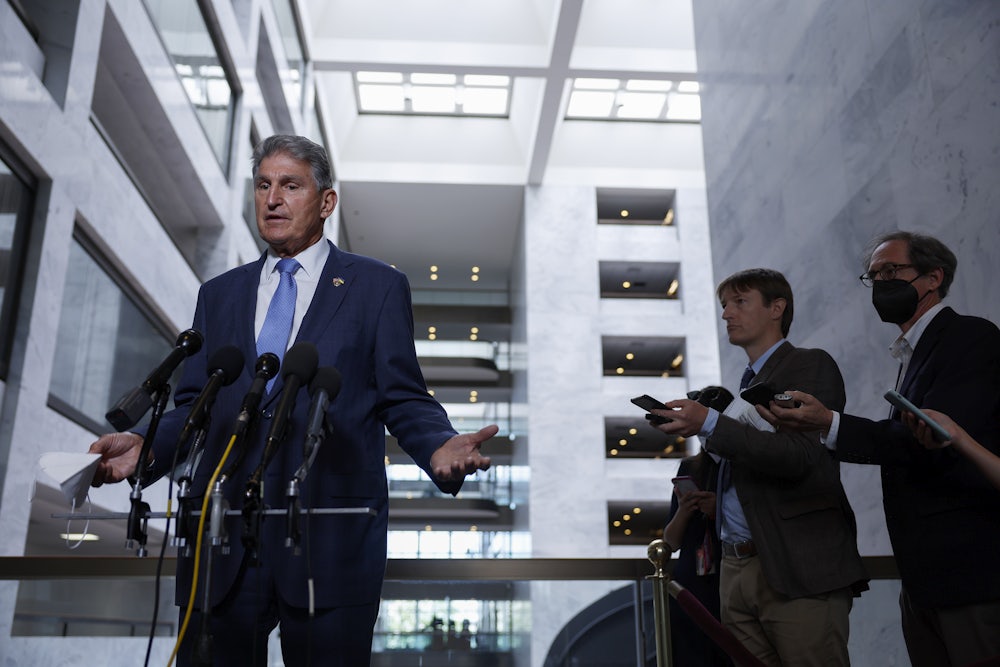It’s a bit hard to get a handle on what’s actually happening with the Inflation Reduction Act. The Senate has seemingly miraculously agreed to a package with $369 billion worth of climate spending, including $260 billion in expanded clean energy tax credits, a $1.5 billion program incentivizing cuts to methane emissions, and a $27 billion public bank to jump-start green technologies. In exchange for all that, West Virginia Senator turned Prime Minister Joe Manchin is demanding a sweeping overhaul of the environmental review processes that govern how and where fossil fuel infrastructure is built, a green light for the Mountain Valley Pipeline, and a host of other sweeteners for fossil fuel companies. Among the giveaways is a provision that requires the Department of Interior to, for the next decade, offer up at least 60 million acres for offshore drilling every year that it leases land out for offshore wind.
So what should be made of this “all of the above” devil’s bargain? Democratic politicians have an obvious incentive for wanting a win and to brush off criticisms about potential trade-offs. Nonprofits, think tanks, and academics commenting on the proposed deal have millions of dollars in grants tied to being able to claim credit for something passing that can feasibly be called climate policy, so won’t exactly give critical quotes to the media in the eleventh hour of negotiations. Journalists who rely on them to craft their analyses are inclined to agree. Those who have criticized the bill for boosting, rather than curtailing, fossil fuels have been smeared as wreckers, or ignored.
Obscured behind all the platitudes about this bill’s “historic” climate investments, however, there’s a cynical and decently compelling case to be made for the compromise. That case runs like this: Republicans are likely to win back the House in November and keep Democrats out of governing power for a decade or more. It’s almost certainly better to pass something than nothing. If the modeling on the carbon cost-benefit analysis is to be believed—that every additional ton of greenhouse gas emissions generated by the bill’s fossil fuel provisions would correspond to 24 tons of emissions saved—then this deal looks much better than nothing. How many fossil fuel giveaways you’re willing to swallow in the process—how many more cases of rare cancers in the Gulf South or pipelines leaking into drinking water sources—depends on what your material incentives are and proximity to those problems. Quickly compiled analyses from a host of think tanks suggest the carbon benefits of the bill could be massive compared to the current trajectory, cutting emissions by an estimated 40 percent below 2005 levels by 2030. That’s a very long way off from what the United States owes the rest of the world—but also the best we may be able to hope for in the short run.
Green groups rallying around the package know it’s not perfect. But there also isn’t much of a working theory from the most enthusiastic boosters about how to win more. The Inflation Reduction Act is structured mainly as a series of tax credits and funding incentives, and its proposed benefits—similar to the $90 billion worth of climate-minded elements of the American Recovery and Reinvestment Act from 2009—accrue mainly to companies. There’s scant money for housing, and funding for environmental justice ($60 billion) is minuscule in the grand scheme of things. If the political strategy behind the Green New Deal was to deliver tangible, immediate benefits that would whet appetites for more sweeping policy, the IRA takes a more conventional approach: Give companies money to do the right thing, and the benefits will trickle down. In boosting both fossil fuels and clean energy, the IRA could play a heavy hand in shaping what the trajectory of the green economy in the U.S. will look like—and who gets rich off it.
Major companies, including big polluters, wouldn’t be pressuring Manchin to pass something if they didn’t have something to gain from it. The same goes for the fossil fuel companies “delighted” by the IRA announcement. (Notably, companies that see little to gain in the clean energy future—like Koch Industries—have been railing against it.) Besides the upsides of having to walk through less red tape to build stuff, savvy CEOs who are now supporting the bill get the reputational benefits of having fought for climate policy—alongside more money for things like hydrogen and carbon capture, which can in turn be used to drill for more oil. In other words, the IRA could be a boon both for fossil fuel executives’ core business model and for their prospects of profiting from the clean energy technologies that might eventually replace them—all without setting out any clear timeline for when that transition might actually happen.
Keep in mind that the scales of the existing U.S. tax regime are tilted dramatically in favor of fossil fuel companies, which collect roughly $20 billion a year in state and federal subsidies. “In-kind” support for the industry—through diplomatic pressures abroad, for instance—has only accelerated since Russia invaded Ukraine and the State Department redoubled its role as a global salesman for U.S. fossil fuels. And companies don’t need much support at the moment. ExxonMobil and Chevron reported record profits last quarter. Just five privately held U.S. and European oil majors are expected to have raked in $60 billion during that time. Those earnings are being made, in large part, from surging prices that are driving cost of living crises around the world and helping stoke fears of a global recession. Central banks are looking at aggressive interest rate hikes to curb inflation, as policymakers balk at the possibility of going directly after high energy prices with price stabilization policies.
Fossil fuels and renewables alike have benefited from the “everything economy” of the last decades, where bottom-barrel interest rates and cheap credit have left investors searching for shiny new places to park excess cash. But whereas fossil fuel companies reap the rewards of reliable subsidies while they continue selling the lifeblood of global capitalism, renewables companies in the U.S. are often unable to even collect what intermittent subsidies have been ostensibly available to them. That’s thanks to the Rube Goldberg–esque structure of existing clean energy incentives, which siphon billions of dollars off to Wall Street middlemen. Thankfully, the IRA would remedy tax credits by introducing a direct pay option. Some of the biggest clean energy developers in the U.S. remain foreign owned, like the state-backed Danish firm Ørsted.
All this leaves U.S.-based solar and wind companies in a slightly precarious position as rates rise and warnings circulate about a possible recession, with precious little time to regain lost ground. Fossil fuels stand on a stronger footing entering the uncertainty ahead, with plenty of cash on hand and bipartisan support to boost production. Those already talking a big game about their commitment to a vaguely timed energy transition—like European supermajors Shell and BP—could be major beneficiaries of the IRA’s fossil fuel and clean energy incentives alike.
This could drive a perverse trajectory: Rising energy costs and new subsidies for the fossil fuel industry could punt an energy transition further and further into the future, all while the clean energy ventures the IRA would spur along stand to simultaneously pad already high energy company profits. Actual clean energy companies, meanwhile, could face a reckoning in an economic downturn.
As the last several months have shown, fossil fuel companies aren’t keen to make investments for the good of either consumers or the planet. Will the IRA make green energy profitable enough to really be worth their while? So far, even comparatively more ambitious European policies haven’t been able to make renewables look like an attractive investment for Big Oil, since margins for clean energy remain comparatively low. Without direct policies to restrict fossil fuels—the deal for the IRA does nearly the opposite—they’ll continue to dominate for years to come. There’s not much reason to believe that a market nudged gently toward wind and solar will foster a strong enough alternative to beat them.
Does all this mean Democrats should abandon the deal? Not necessarily. But there should probably be an intellectually honest debate not just about the pros and cons of the deal on paper but about the future this bill could build.










